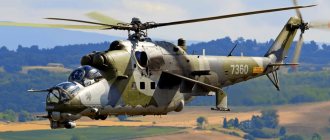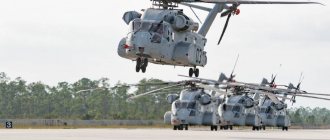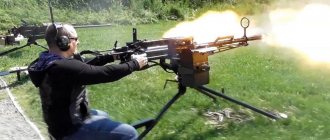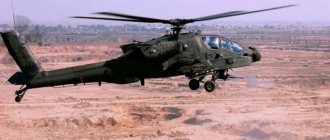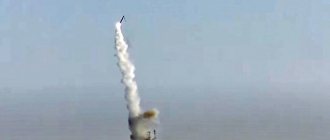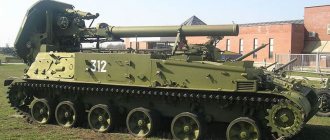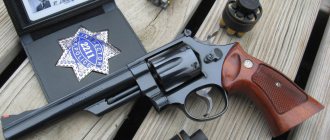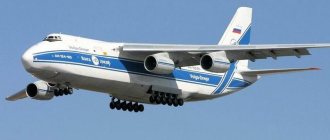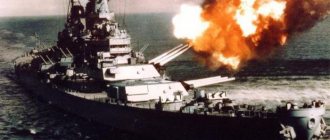On July 10, 1968, the Mi-12, the heaviest and most load-lifting helicopter ever built in the world, took to the skies for the first time. This “heavyweight” still amazes with its size: the diameter of each propeller is 35 meters, and up to 220 people could sit inside the helicopter.
Today, more than half a century since the first flight of the Mi-12, Russian heavy helicopters continue to occupy first places in the ranking of the largest rotorcraft in the world. Let's remember the legendary giant helicopters of domestic production.
Mi-12 helicopter. Photo. Story. Characteristics.
The Mi-12, codenamed "Homer" by NATO, is the heaviest cargo aircraft ever produced. The main difference between this model and the standard helicopter design was the lateral placement of propellers on the wings, driven by D-25VF engines. According to the developers, the B-12 (the initial name of the project) was supposed to have a payload capacity of over 30 tons with the ability to transport elements of ballistic intercontinental missiles on it.
Russian Aviation
The B-12 helicopter, according to the NATO classification Homer - “Homer” - is the heaviest and most load-lifting helicopter ever built in the world. A distinctive feature is the lateral arrangement of propellers on the wings of reverse narrowing, which are driven by four D-25VF engines.
The B-12 was developed as a super-heavy transport helicopter with a payload capacity of at least 30 tons for transporting components of intercontinental ballistic missiles for units of the Strategic Missile Forces or creating position areas, the placement of which was planned on terrain without paved roads.
On August 6, 1969, the B-12 lifted 44,204.5 kg of cargo into the sky in a record attempt. This achievement has not only not been surpassed so far, but is unlikely to be surpassed in the foreseeable future. For comparison: the maximum weight that the largest helicopter currently produced, the Russian Mi-26, “took” is 25 tons. And a comparison with the largest Western helicopter, the Sikorsky CH-53K with a payload capacity of 15.9 tons, is hardly appropriate at all. The B-12 could lift the entire CH-53K, with maximum loading and refueling, and still have almost 6 tons of “reserve” left. But we are talking about the latest modification of the heavy Sikorsky, created in 2015.
The width of the B-12 at the ends of the blades was 67 m, which exceeded the wingspan of a Boeing 747
At the time of its first flight in 1968, the B-12 was twice the size and four times the mass of the largest foreign helicopters. This helicopter was the last creation of the famous designer Mikhail Leontievich Mil. The B-12 is its greatest triumph and greatest failure. The letter “B” denoted experimental vehicles before they were put into production, but the B-12 never became known as Mi.
The experience of creating the B-12 was useful in the development of the Mi-26, the largest and most heavy-duty production helicopter in the world. The Russian Helicopters holding company is rightfully proud of its presence in its production line.
The V-12 was not created for the sake of records. The assignment for the helicopter project “for the transportation of integral cargo weighing 25 tons” was issued in 1962, not with the goal of astonishing the world or rubbing the Americans’ noses. This was the most important state task. It was necessary to ensure a nuclear retaliatory strike capability in any conflict scenario with the United States. But in the early 1960s, silo-based missile systems were just being created, and the hope for submarines and strategic bombers in conditions of total domination of a potential enemy in the oceans and surrounding airspace was quite illusory. Calculations showed that a sudden nuclear strike on the USSR would be disarming.
The guarantee of the safety of sufficient means for a retaliatory strike was provided by mobile ground-based strategic missile systems, which could constantly change their position. Given the poorly developed road network, we had to think about how to move them by air. For this purpose, a system of two aircraft was conceived: a heavy An-22 Antey transport aircraft, which would deliver the missile to a remote airfield, and a helicopter capable of transporting it even further, to places where not only roads, but also unpaved landing strips. There were even plans to turn the helicopter into a mobile launch position (Project B-16), but this was already beyond the capabilities of the technology.
The An-22 and V-12 (like the An-12 and Mi-6 before them) were necessary links in the same transport chain. Even the dimensions of their cabins were unified for the same “one-piece” loads. But if aircraft of this size already existed in the world and the creation of the An-22 became a complex but understandable task, then the development of a helicopter of similar dimensions and weight required fundamentally new solutions.
Full-scale test bench
It all started with choosing the optimal scheme. All over the world, the most suitable configuration for heavy helicopters was considered the so-called flying car - a longitudinal design with two rotors, according to which the heaviest American helicopter at that time, the CH-47 Chinook, was made. However, this approach had a number of significant drawbacks. For example, the front propeller “shaded” the rear one in flight, and the long “car” of the fuselage, falling into the blowing zone of the main rotors, significantly reduced their efficiency. In addition, the longitudinal helicopter could not take off from a running start, like an airplane, which greatly reduced its maximum carrying capacity.
Mil wrote in his diary: “How to create the next, heavier helicopter? It is almost impossible to calculate the parameters of the optimal design - the designer must weigh too many conflicting considerations... Sooner or later he is faced with the question of the advisability of further increasing the diameter of the main rotor and switching to a two- or multi-rotor design... Essentially, there are not many combinations: two-rotor ( longitudinal or transverse design) and three-rotor helicopters." Three-screw and even four-screw designs were considered, but both were rejected: analysis showed that the required lifting capacity (25 tons) could be provided by two screws.
The debate over the choice of scheme was very heated. The Yakovlev Design Bureau, based on the experience of developing the Soviet “flying carriage” Yak-24, proposed a grandiose project B-38 with a longitudinal design. M.L. Mil insisted on a different solution.
Assembly of the first flight prototype in the workshops of the cost center
On January 21, 1965, Mil writes in his diary: “Yesterday the conference in Panki was held brilliantly. Everyone liked my report. There were Redkin, Maksimov, the entire apparatus of the Council of Ministers from the Central Committee, Pyshnov from the Air Force, a total of 450 people. Wildgrube spoke, he criticized the B-12, and said that without changing the load, it was possible to make the car twice as light in a longitudinal design. We decided to beat him. Tishenko, Nekrasov, Radin and I spoke. Wildgrube performed again, you had to see him.”
After 5 days, a new entry in the diary: “For a week now, almost every day in the morning, the head of TsAGI, Myasishchev, comes to us for half a day with his assistants (8 people). Together with Fedulov and Wildgrube, they understand my new scheme, comparing it with the longitudinal one. And we, of course, stay late in the evenings. Today is almost a final victory. Myasishchev for us... The day after tomorrow the commission. Instead of being twice as bad, our machine is twice as good as the longitudinal one, and overall the solution is excellent.”
When designing the Yak-38, even at the “paper” stage, the designers encountered such difficulties that the project was closed, and the helicopter theme disappeared forever from the work of the Yakovlev Design Bureau.
The transverse design was also supported by the fact that it made it possible to take as the basis for the project a ready-made propeller-engine group of the Mi-6 heavy helicopter with two D-25V turbo engines and a five-bladed propeller with a diameter of 35 m. This significantly accelerated the development. The effectiveness of the chosen solution is also evidenced by the fact that as a result of “doubling” the power plant, the V-12’s payload capacity has more than doubled compared to the Mi-6 with its 12 tons of maximum load. True, for this it was necessary to use forced versions of the D-25VF engine with an increase in hp by 1000. (up to 6500 hp) power and lightweight composite blades (each blade has become 300 kg lighter). However, a certain “gain factor” should also be attributed to the transverse screw arrangement.
After choosing the design, it was necessary to decide how to build “bridges” connecting the rotors: transversely or longitudinally. First, we decided to analyze the advantages and disadvantages of the longitudinal design used on the Soviet Yak-24 helicopters and the American V-44, which M. L. Mil acquired on behalf of the government during a business trip to the USA in 1960. Three Yak-24s were taken from the military, driven from Torzhok to a test airfield in Panki, and they began to fly them and study their flight characteristics. This work was carried out by test pilots V.P. Koloshenko, R.I. Kaprelyan and G.R. Karapetyan.
During the tests, uneven loading of the front and rear gearboxes, large vibrations, and instability of the helicopter in flight were discovered. The same shortcomings appeared during tests of the American helicopter. After an exhaustive analysis, Mil finally settled on a transverse design. A helicopter of this design was built in Germany by Heinrich Focke before the war. His FW-61 was mass-produced. Our transverse helicopters were designed by I.P. Bratukhin and N.I. Kamov.
Five years of work on the B-12 became for M. L. Mil the years of the highest creative growth. “This car will be the best I’ve ever created, believe me,” he told his wife.
The OKB announced a competition for the best design solution. It was attended, on the one hand, by A. S. Braverman and A. M. Blok, on the other, by M. L. Mil, O. P. Bakhov and other young designers. Work has begun on the preliminary design.
In order to spread the propellers far enough apart, they had to be placed together with the engines at the ends of two wings, supported by a truss structure. The difficulty was to avoid the unwanted vibrations inherent in the transverse design and the dangerous resonant vibrations that engines suspended at the ends of the wings could cause.
On the one hand, the wings in flight created additional lift and thereby increased the load capacity, but, on the other hand, there was a problem with a decrease in the efficiency of the propellers due to the fact that part of the air they threw was obscured by the wing. To reduce this effect, the wings were made to taper towards the junction with the fuselage, where the flow velocity from the propellers is maximum. This solution made it possible to increase the lift force by 5 tons. Reverse tapering wings were considered a major invention and were patented in England, France and Italy.
Engines during maintenance
We had to solve other problems as well. To prevent the propellers from colliding, and their blades, according to the design, to overlap each other by 1.5 meters, it was necessary to achieve absolute synchronization of their rotation. For this purpose, a special transmission shaft was designed that connects the main gearboxes. An intermediate gearbox was installed at the fracture of the shaft where the wings join. The synchronous shaft served to transfer power from one engine to another. This significantly complicated the helicopter’s transmission, but the connecting shaft ensured the transmission of torque, so that the helicopter could continue to fly even if two engines on one side failed.
Other interesting solutions were also used. For example, the question arose: how can mechanics service engines located at high altitudes? After all, not at every airfield you can find stepladders 12 m high, not to mention the field conditions for which the helicopter was, in fact, intended. A solution was found: stepladders replaced the hinged engine hood covers. The mechanic went out of the cab onto the “roof”, walked along the wing to the engines and, standing on the hinged hood, worked on them. But this was only a small thing compared to the fundamental problems that had to be solved when creating the B-12.
Perhaps the most triumphant page in the history of the B-12 was a visit to the Le Bourget air show in 1971. The helicopter traveled to the suburbs of Paris from Moscow under its own power, since it was almost impossible to transport a colossus of this size in any other way.
Initially, it was planned to lay out a safe route over land, part of which was supposed to pass over the territory of the Federal Republic of Germany. However, the West Germans, without explanation, denied the B-12 access to their airspace, so they had to fly over the Baltic and North Seas under unfavorable weather conditions. However, the technology did not disappoint.
At the Le Bourget air show, the cargo compartment, equipped with a drop-down ramp and measuring 28.15 x 4.4 x 4.4 m, was compared to a Gothic cathedral.
At the air show, the general public was amazed by the size of the rotary-wing giant. What were the main landing gear wheels with a diameter of 1.7 m alone worth! The width of the B-12 at the ends of the blades was 67 m, which exceeded the wingspan of the Boeing 747. The two-story cabin for a crew of 6 people, and the huge aircraft tail necessary to control the aircraft, which reached a speed of 260 km/h, were amazing. Equipped with a drop-down ramp, the cargo compartment measuring 28.15 x 4.4 x 4.4 m was compared to a Gothic cathedral.
Cargo compartment intended for transporting strategic missiles with nuclear warheads
Experts first of all noted that the celestial giant with a take-off weight of 105 tons and a total engine power of 26,000 hp. flies surprisingly quietly, easily and smoothly. On the way to increasing the take-off weight and size of a helicopter, there is a terrible enemy - vibration. The first copies of the Yak-24, the Soviet “flying carriage” with a longitudinal design, shook so much that the pilots jumped in their seats.
In this regard, the choice of direction of rotation of the screws was of great importance. Most experts insisted on rotation, in which the blades seemed to “rake” towards the fuselage. This pattern is called “butterfly”. But Mil insisted on “breaststroke”, when the blades move outward from the fuselage. The designer believed that the helicopter would be more controllable in this case.
While studying the stability and balancing of the helicopter, the General Designer was convinced that when rotating the propellers according to the “breaststroke” pattern, the control efficiency at the moment of roll increases. If the propeller rotates in the opposite direction, then conditions may arise during the roll under which the control fails. The pilot moves the stick all the way to the right, fully “squeezes” the pedal, and the car, performing a spiral, still tips over the left wing.
The question was so complex that the designer was theoretically unable to prove that he was right to his opponents. Only practice confirmed the correctness of the choice: the B-12 could continue stable flight for 7 minutes with the control stick thrown down. The giant flew not only with a low noise level, but also very smoothly, almost without vibration.
Test pilot Vasily Koloshenko said: “It was like I was sailing on a huge ship.”
The absence of vibrations in the cockpit was also influenced by the successful design: the distance from the engines fuselage and the rotation speed of the huge propellers being three times lower than in other helicopters.
To ensure the absence of vibrations, before the start of flight tests, the first copy of the B-12 was properly shaken: the helicopter was secured on shock-absorbing suspensions, and instead of blades, electric motors with an asymmetric load were installed. The tests continued for a whole month, and yet not all problems could be identified on the ground.
Rolling out the B-12 helicopter from the assembly shop in the spring of 1967 for finishing work
The first flight of the B-12 was scheduled for June 27, 1967. The helicopter's creators, representatives of research institutes, factories and related enterprises, the Ministry of Aviation Industry, and the military gathered at the factory's flight test complex. To the aviators' march “We were born to make a fairy tale come true,” a powerful tractor pulled the helicopter out of the workshop. He couldn’t turn around there and rode out tail first. Someone said quietly: “Bad omen.” Mikhail Leontievich heard this and became gloomy, he was superstitious.
Pilot V.P. Koloshenko turned the helicopter against the wind, taxied to the right, to the left - the car obeyed. Then he began to increase engine speed in preparation for takeoff. Finally, the helicopter smoothly lifted off the ground and hovered. And suddenly the car began to dance, began to slowly sway from side to side, then tilted and, not obeying the control stick, went down lopsidedly. When the helicopter touched the ground, the tires bent to one side and the wheels hit the concrete flange. One of them broke and the camera burst with a loud bang. So many hopes have been dashed!
Very soon after the failure, Mil fell ill, and the shortcomings of the B-12 control system, discovered after the accident, were corrected without him, although they regularly and thoroughly reported everything to the General and received instructions and advice in response.
The reason lay in the imperfection of the control system, which turned out to be much longer and more ramified than its counterpart on the Mi-6. The rigidity of the rods was not enough for the pilot to be able to counter the roll of the air giant with sufficient speed. As a result, self-oscillations arose that the pilot could not cope with.
A year later, on July 10, 1968, they decided to take the car into the air again. Again a lot of people gathered, and Mikhail Leontyevich also arrived. This time the flight was successful, although they pulled the helicopter out of the hangar, as the first time, tail first. The giant, weighing about 100 tons, rose with amazing ease; in the sky it was unusually beautiful. Accompanied by two Mi-10s, the helicopter flew to a test airfield, from where it made more than a hundred test flights.
Takeoff of the B-12 “like an airplane” - from a running start
Next was the triumph at Le Bourget, which became the best “salute” to Mil, who passed away in 1970. Preparations for the new machine for mass production have begun. But in 1974, a decision was made to stop working on the project. Over the 12 years that the grandiose machine was being fine-tuned, the situation has changed. Developers of strategic missile systems have managed to create solid-fuel missiles that are light and compact enough to be hidden in a railway carriage or placed on an all-terrain vehicle chassis. The country's nuclear deterrent forces became completely invulnerable to a sudden enemy strike, and the military no longer needed the huge helicopter. The declared capabilities of transporting 196 soldiers at a time did not interest them, and the unique vehicle turned out to be too expensive for transporting civilian cargo.
The B-12 had no competitors. Powerful helicopters Mi-10K (or B-10), Sikorsky S-64-F, Boeing-Vertol CH-47C Chinook lifted a load of 11-15 tons.
For success in creating the most lifting helicopter, the Design Bureau of M. L. Mil was awarded the second International Igor Sikorsky Prize established by the American Helicopter Association.
The son of an outstanding aircraft designer, the representative of his company in Europe, Sergei Sikorsky, wrote: “One can only take off one’s hat before the engineering and technical achievement that is the B-12 helicopter... This helicopter is one of a kind and will be used to perform unique operations. I mean expeditions to the Arctic regions or searches for oil fields. The helicopter will replace the railway where no man has gone before.”
A total of two copies of the B-12 were built. One of them is now kept in the Air Force Museum in Monino, the second is on the territory of the Moscow Helicopter Plant. M.L. A mile, and when passing the Pankie platform on a train, an attentive passenger can still notice its gigantic outline above the fence.
The experience gained during the creation of the B-12 turned out to be in demand during the development of the Mi-26. This helicopter is currently the largest and most lifting production helicopter in the world. The Mi-26 was created according to the classic single-propeller design, but with new engines, propellers, and control systems. It is much more suitable for everyday use not only in the military, but also in the civilian segment. However, the B-12 will forever remain an unsurpassed example of how a real technological miracle can be created mainly due to the ingenuity and courage of design ideas.
Sources:
- VTB (https://vtbrussia.ru/tech/vertolet-v-12-chudo-tekhniki-chast-2/)
- Science and life (https://www.nkj.ru/archive/articles/11160/)
- 10/28/2016 October 28 - Army Aviation Day of the Russian Aerospace Forces
- 11/24/2016 Mi-26T helicopter evacuated An-2 from the ice of the Northern Dvina
- 12/18/2021 A trade-in program is being developed for the helicopter industry
- 06.16.2021 Technical means for training helicopter flight personnel installed in Syzran
( 9 ratings, average: 5.00 out of 5)
V-12 helicopterKB named after. MileMi-12Mi-26
Purpose
Military aviation and the national economy were in great need of transporting integral cargo with a total weight of over 20 tons using the vertical type of takeoff and landing. In theory, the Mi-12 was supposed to be such a device. The purpose of the helicopter was taken into account in transporting cruise and ballistic missiles, self-propelled artillery units (such as Su-100), PT-76 and T-54 tanks, and armored personnel carriers. In total, this universal helicopter could transport up to 80 types of various equipment and weapons.
During the Cold War, air defense systems were built at strategic points in the USSR. And there was an urgent need to create a heavy lifting aircraft and helicopter that could transport solid heavy missiles in a short time. The B-12 was developed in tandem with the An-22 aircraft. The plane’s mission was to transport military equipment to the airfield, and the B-12 to the nearest position. Therefore, the dimensions of the cargo compartment of these two aircraft were designed to be the same.
Tests of the B-12 were quite successful. There were 122 flights and 77 hoverings, which demonstrated the high efficiency of all helicopter systems.
Mi-10: “flying crane”
Soon after the first flight of the Mi-6, the Mil Design Bureau began developing a new model - the Mi-10 (“flying crane”). The helicopter first took to the air in 1960.
The new car was created on the basis of the Mi-6, but the developers conceived a number of innovations. First of all, the project implied the abandonment of the large size of the cargo compartment, and therefore the fuselage, which was supposed to significantly lighten the design. The crane helicopter did not need a large supply of fuel. It was assumed that it would transport goods over short distances.
The new helicopter received a high four-legged landing gear, which made it possible to “land” on large cargo up to 3.5 meters high or transport them on a platform under the fuselage. By the way, under the fuselage it was possible to place various specialized containers: a passenger cabin, a cargo container, a fuel tank, a sanitary operation point, a mobile laboratory and others.
As a result, several modifications of this helicopter were created: for radio reconnaissance, for transporting a universal field laboratory, and a “short-legged” version of the Mi-10K (“Crane”), designed specifically for construction and installation work.
It was the Mi-10K that represented the USSR at the Paris Air Show in 1967. Soviet helicopters Mi-6, Mi-10K and Mi-8 reached Paris “under their own power” in a few days. Then they made a real splash at the air show. “American industry cannot do anything against the Mi-10 flying crane, which can carry 15 tons of cargo... on a platform sandwiched between a chassis that looks like stork legs,” wrote the English magazine Economist. The French aviation publication Aviation called the display of Soviet helicopters one of the biggest sensations at the salon. “The demonstration was so majestic that it made you forget about the “heaviness” of these machines. This is especially true for the Mi-6 and Mi-10,” wrote the French magazine.
Among the record-breaking achievements of the Mi-10 is the development of the richest gas and oil fields in Eastern Siberia, as well as incredibly complex construction and installation work, not only at home, but also abroad. For example, in 1966 in Switzerland, the Soviet crew on the Mi-10 carried out work on installing cable car supports in the mountains, and then on installing the huge dome of the astrophysical observatory in Bern. “Flying cranes” managed to serve well into the new century. In 2003, a Mi-10K helicopter installed a 48-meter spire on the Triumph Palace building in Moscow.
Advantages of the Mi-12
- Excellent handling, even with autopilot turned off
- High level of controllability during rotational actions
- Low engine power in forward flight
- Good noise and vibration insulation, high level of comfort in the cockpit
As test flights have shown, even when running on two of the four engines, the helicopter has enough power to take off with mileage. The helicopter's flight characteristics are almost no different from the Mi-6, but the size of its cargo compartment has been increased by more than 7 times.
Unfortunately, despite its gigantic dimensions and universal functionality, the B-12 never reached mass production. Several reasons can be found for this phenomenon.
- By the end of the 60s, the build-up of strategic missile bases lost its relevance, and the costly transportation of air defense equipment was no longer required. And other types of cargo were also not suitable for transportation on the B-12, based on profitability considerations.
- The Saratov Aviation Plant rejected the production of the B-12 due to the plant's capacity being loaded with other important orders.
- Design work has begun on the creation of the Mi-26, which is inferior to the Mi-12 in terms of carrying capacity, but superior in a number of other indicators.
At OKB im. Mil, simultaneously with the B-12, were developing the super-heavy helicopter B-16, which has a payload capacity of 40 to 50 tons. It was assumed that this device would be able to transport heavy military equipment and air defense equipment. In fact, it was in this model that they tried to correct some of the shortcomings of the V-12 by using six D-25VF engines and a three-propeller power plant.
However, a little later, the idea arose to install two D-30V gas turbine engines with a total power of 40,000 hp on the V-12. and increasing the blades from three to six on each propeller. In 1966, the project with these changes was named Mi-12M. According to preliminary calculations, the capacity of the modernized model should have been enough to transport cargo with a total weight of 25 tons per 500 km and 40 tons per 200 km. The government gave the go-ahead for the development of the project, but due to the termination of the B-12 program, the matter did not progress beyond the creation of a full-size model of the helicopter.
Mi-6: the first heavyweight record holder
Development of the Mi-6 began at the Mil Design Bureau in mid-1954. The helicopter made its first flight on June 5, 1957, and five months later this machine set an absolute record for lifting capacity: a load weighing 12,000 kg was lifted to a height of 2432 m.
The Mi-6 record became sensational for the whole world. It was difficult for foreign experts to imagine that the USSR had produced a helicopter with twice the payload capacity of the American S-56. At that time, the Sikorsky company was conducting research on several heavy helicopter projects at once, but did not dare to create a machine similar to the Mi-6.
First flight of the heavy multi-purpose helicopter Mi-6
The Mi-6 surprised not only with its size, but also with many technical innovations. First of all, the design of the vehicle itself was of interest: a single-rotor design, a streamlined aircraft-type fuselage, above which two gas turbine engines are installed, and a large cargo compartment with a rear cargo hatch. This design was destined to become a classic for domestic heavy transport helicopters. The main rotor with a diameter of 35 meters, developed for the Mi-6, had no analogues in the world.
For the first time, a controlled wing was installed on a helicopter, which relieved the load on the main rotor during cruising flight and made it possible to achieve high speed. In September 1961, the Mi-6 showed the whole world that it was not only the most load-bearing, but also the fastest helicopter in the world. He reached a speed of 300 km/h - the maximum speed for helicopters at that time. For this record, the American Helicopter Society awarded Mikhail Mil the International Sikorsky Prize in “recognition of outstanding achievements in the development of helicopter art.”
The Mi-6 broke a total of 16 world records. Various modifications of the record holder managed to serve in many areas. In particular, in 1965 the passenger Mi-6P was created. The search and rescue version of the Mi-6PS was used to search for landed spacecraft. Mi-6PZh helicopters fought forest fires. In total, between 1959 and 1980, about 900 Mi-6 helicopters were produced.
Mi-12 design
In the development of a super-heavy cargo helicopter, a number of problems arose, which were complicated by the gigantic dimensions of the designed device. A huge brainchild of the OKB named after. The Mil had 4 engines and a transverse twin-screw design. Fastening of the propeller-motor groups was carried out at the ends of the truss consoles. The propellers had to be installed larger in diameter than on all previously known helicopters.
A little later, OKB im. Solovyov created a unique modification of the D-25F engine for the Mi-12. The transmission shaft of this rotorcraft supplied power from the engine gearboxes and functioned even in conditions of partial or complete failure. The fuel was placed in mounted and wing tanks.
The fuselage of the Mi-12 is made as a semi-monocoque and resembles, in the figurative expression of one of the developers, a huge Gothic cathedral. At the front of the fuselage there is a two-story control cabin. The lower floor is intended for two pilots, a flight electrician and a flight engineer, and the upper floor is for a navigator and flight radio operator. At the rear of the fuselage there were side doors and a power ladder. During the opening, an opening was created for the entry of equipment and loading using hoists and electric winches. In the central part of the fuselage there was a huge cargo compartment with dimensions of 28x4, 4x4.4 m. 196 soldiers could be placed inside it.
Under the rear part of the fuselage there was an aircraft-type tail unit, with rudders and elevators and vertical washers. Increased control efficiency was achieved through the control rudder, and the elevator synchronized the control of the helicopter along with the main rotors. The lifting force was regulated by simultaneously changing the pitch of the rotors. Differential control was responsible for controlling the vehicle's roll.
To regulate the values of propulsive force and longitudinal balancing, changes in the cyclic pitch of the screws were used, which were achieved by the operation of swashplates.
The Mi-12 helicopter had a tricycle landing gear. On the front pillar there was a double castor wheel, which was located under the control cabin. Two main landing gear with twin wheels were located under the right and left trusses. The design of the rear fuselage of the Mi-12 also included tail supports, which made it possible to load heavy equipment into the cargo compartment.
During state tests, complaints were mainly about the equipment of the helicopter, so improvements were made in this direction.
In addition to the AP-44 autopilot, another autopilot VUAP-2 was added, which after a short time was replaced by the AP-34B1. The Latsia radar station was also introduced into the design.
Changes also affected the structure of the blades. Thus, on the Mi-12, composite blades with a steel spar, a fiberglass tip and a foil honeycomb filling were tested for the first time.
Multi-purpose character: Ka-62
The Ka-62 is a promising multi-purpose helicopter, the first for the Kamov Design Bureau made not according to a coaxial, but according to a traditional design. Today, the Russian Helicopters holding continues to test the aircraft, and the launch of mass production is planned for 2022. The main areas of application of the new helicopter include passenger transportation, rescue operations, and work in the oil and gas field. In addition, the Ka-62 can receive a naval version and also be used in the Arctic.
The Ka-62 tail rotor is made in a closed form of the “finestron” type. The helicopter's carrying capacity is up to 2.2 tons in the cabin and 2.5 tons on the sling, or 15 passengers. The engines used are French Ardiden 3G with a power of 1680 hp. With. The Ka-62 can reach speeds of up to 310 km/h and is characterized by increased impact resistance. Flight range is more than 650 km at a cruising speed of 290 km/h. According to the manufacturer's plans, most of the airframe (up to 60%) and the propeller blades will be made of modern composite materials, which will significantly reduce the weight of the machine. The Ka-62 became the first helicopter in the world to be equipped with a general helicopter equipment control system.
Chronology of creation
- The design of the super-heavy helicopter V-12 (Mi-12) began in 1959.
- 1961 - the USSR government was given the task to construct a helicopter with a lifting weight of 20 to 25 tons.
- 05/03/1962 - at a meeting of the Council of Ministers of the Soviet Union, a resolution was adopted on the creation of the B-12 helicopter, which would have a cargo cabin like the An-22 aircraft.
- April 1965 - a decree was issued on the construction of the first test copy of the B-12.
- In the summer of 1967, the first sample of the B-12 was transferred to state flight tests. The first flight took place in Pankki on June 27, 1967; test pilot V.P. was at the controls that day. Koloshenko. In this flight, self-oscillations of the “control system - structure” type were obtained for the first time. The negative aerodynamic phenomenon was eliminated by tightening the control system. The ends of the stabilizer were secured with additional vertical washers.
- Beginning in December 1967, the B-12 was systematically launched into the air, and a month later the state test program was successfully completed.
- In 1970, the State Commission gave the green light to serial production of the Mi-12.
- In the summer of 1971, the helicopter took part in the air exhibition in Le Bourget (France), where it received the prize named after. Sikorsky. After the exhibition, he made several demonstration flights over Paris, Copenhagen and Berlin.
- The second copy of the Mi-12 was assembled at the Moscow Helicopter Plant only in 1973. It was distinguished from the first copy by more rigid controls and reinforced tail supports. Today this machine is in the Air Force Museum in Monino, and the first B-12 was transferred for eternal storage to the Design Bureau named after. Mile.
Brief summary
Currently, the record-breaking helicopter, the best aircraft of the legendary designer Mil, has been laid up in the Aerospace Forces Museum in Monino (Moscow region) for more than thirty years. The Mi-12 still has no equal in terms of payload capacity. Its “relative” Mi-26, which lifted a load of 25 tons, can partly compete with it. Modern helicopter technology abroad can handle loads weighing no more than 15 tons. Who knows, maybe the time of our giant will come and he will be able to be useful?
History of the car and modern times
The largest helicopter in the world, the B-12, was taken into the air by the leading tester of the time, Vasily Koloshenko. This happened in 1968. Six months later, load capacity tests began. In August 1969, the B-12 lifted a cargo weighing 44,205 tons to a height of 2,255 km, setting a world record. No helicopter in the world has ever managed to beat this figure.
In 1971, the B-12 was presented at Le Bourget, captivating all visitors to the exhibition. The truck won the prestigious American I.I. Sikorsky. In total, two prototypes saw the light of day; later the program was found to be ineffective. There were no technical reasons for this, it was simply that by that time there was no longer a need to transport heavy weapons by military helicopters. Rocket science has made it possible to create lightweight and powerful ballistic weapons.
Since then, the history of the military machine has ended. The first prototype is at the manufacturing plant, the second has been transferred to the Central Air Force Museum. The factory copy was also turned into a museum exhibit.
Sikorsky CH-54 Tarhe
The Sikorsky CH-54 Tarhe
helicopter model was created in 1962 specifically for the United States Army. Used during the Vietnam War.
Initially, a helicopter was built with piston engines built into it. But we decided to make a model even more powerful and better.
The first such helicopter was made in 1962. Equipped with a fairly high chassis. Thanks to this, the model could be suspended on a variety of platforms. It also has the ability to transport even large loads. The characteristics greatly pleased the customers and the army.
It is worth noting that some models were purchased by private companies. In most cases, they are used for transportation and trawling of timber. But in the fire-fighting version there is an additional water tank.
Sikorsky CH-53E
The model, which is called Sikorsky CH-53E , is one of the heavy transport helicopters. First flew in 1964. A total of 522 such vessels were built.
Quite a few structures were involved in production as well as development. It was decided to build something new, better than previous models. The United States lost approximately 36 helicopters during the Vietnam War.
One of the cases occurred in Israel. The engine caught fire, but the pilots managed to escape. They managed to land the helicopter on the ground, but then it exploded.
Specifications
The dimensions of the helicopter are impressive:
- Length: 37 m;
- Height: 12.5 m.
It accommodates 196 passengers and up to 10 crew members, depending on the mission. The standard crew consists of 6 specialists.
Scheme V-12
The empty weight of the helicopter is 69.1 tons, with a normal take-off weight of 97 tons and a maximum weight of 105 tons. Thus, the vehicle is capable of transporting over 35 tons of cargo. It was assumed that the helicopter could replace a heavy transport aircraft.
The diameter of the rotor is 35 meters, it sweeps an area equal to 1924 m2. Helicopter wings have the shape of a reverse taper, that is, they become smaller closer to the body. The propellers are driven by a D-25VF engine, developed by OKB-19 in Perm in the 50s of the last century. The same power plants were installed on other helicopters:
- Mi-6;
- Mi-10;
- Mi-10K.
The flight characteristics of the constructed helicopter are as follows:
- Flight range: used in practice - 500 km, for ferrying a vehicle - 1000 km;
- Flight altitude: static - 600, and practical - 3500 meters;
- Speed mode: cruising - 240 km/h, maximum - 260 km/h.
Development showed that the project would be quite expensive; solutions were quickly found to reduce the cost of the project. In total, the Moscow enterprise produced 2 helicopters of the series.
